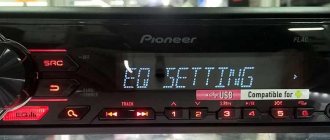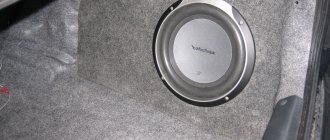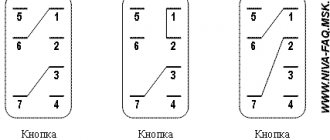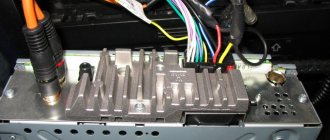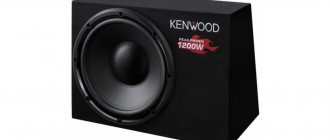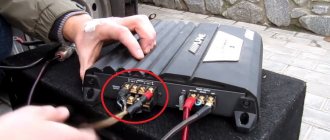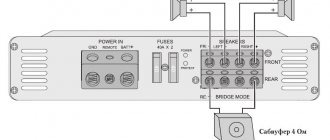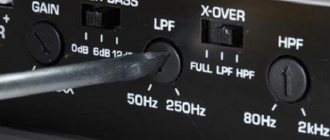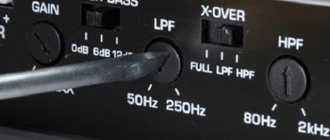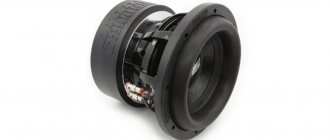The subwoofer is an important part of the car music system. Working at high power and low frequencies, it gives the sound a rich and rich sound. Conventional acoustic speakers have a number of limitations in the range of reproduced frequencies. They are not able to provide deep bass, without which musical fragments lose their strength and expressiveness. Speakers are divided into passive and active devices. A passive subwoofer consists of a loudspeaker specifically designed to reproduce low frequencies, a crossover filter, and an enclosure. Such a system requires a low frequency amplifier. The LF system can be connected to the terminals of a multi-channel amplifier or a separate amplifier can be provided for it. The active system for reproducing low frequencies has a special amplifier with a filter system. It is built into the housing where the woofer is located. In order for the car's sound system to work correctly, you will need to configure the subwoofer in the car.
How to set up a car subwoofer
The low-frequency component of the audio range is a narrow frequency band that starts from approximately 18-20 Hz and ends at 120-150 Hz. It is in this range that any subwoofer operates. Correctly setting up a subwoofer in a car is an important process on which the quality of low frequency reproduction will depend. If the sound system is not tuned, then the bass notes will “scatter” and lose pressure and richness. Instead of a rich and thick bass, a monotonous boom will be heard from the speaker, which, according to impressions, is in no way connected with the melody.
Setting up a subwoofer in a car depends on several factors:
- Speaker installation location
- Its power
- Operating frequency range
Typically, subwoofers in a car are installed in the luggage compartment or under the seat. If the column is installed under the seat, then too much power, if the system is not configured, can cause negative sensations for the driver and passengers.
Setting up an amplifier for a JBL subwoofer
An important step in preparing a low-frequency amplifier is frequency matching. The adjustment ensures harmonious and unison reproduction of two sound subranges related to bass frequencies. This is mid-bass or mid-bass and the lowest sounds a speaker can produce. The LPF filter was previously installed. However, the initial position may differ from the bass band produced by the front speakers. This can lead to noticeable gaps in the audio range. For example, if the LPF filter was set to 45 Hz and the front speakers were set to 90 Hz, there would be a large drop in sound level between 46-89 Hz. Of course, the filter will not cut off this band at all, but the sound quality will deteriorate. In order to adjust playback levels in different parts of the audio range, you need to adjust the LPF filter. This is done as follows:
- Play a fragment rich in bass from the car radio
- Turn the filter adjuster a few notches counterclockwise
- If dips persist, increase the level by turning in the opposite direction
How to properly set up an active subwoofer in a car
By reproducing low frequencies, the unit allows you to expand the dynamic range of any musical work. Speakers located in the doors or on the front panel are not designed to reproduce bass confidently. A properly configured subwoofer copes well with this task. The car bass amplifier panel contains several adjustments that allow you to fine-tune the low-frequency speaker system. Setting up an active subwoofer in a car on an amplifier includes the following adjustments:
- Gain (Level) – input sensitivity
- Sub Sonic – low pass filter
- Phase – phase adjustment
- LPF (Low pass filter) – low pass filter
- BassBoost – increase the volume in a narrow frequency band
To know how to properly configure an active sub, you need to understand what each adjustment is responsible for.
Setting up the amplifier for the subwoofer and front
In order for the bass frequencies not to “scatter”, but to sound in complete harmony with other channels, acoustic phase correction is performed. This parameter is best adjusted according to the driver’s subjective feelings. The “Acousticphase” regulator is located under the slot on the amplifier panel. You need to slowly turn the phase control until the bass frequencies reproduced by a separate speaker sound in the same plane. This is a subjective feeling, but if the phase is chosen incorrectly, it will seem that the bass and front are working separately, and there is no sense of harmony and integrity of the sound. Acousticians call this sound delamination. It is best to listen to a musical fragment and set the acoustic phase in the driver's seat, where the disturbances are most clearly noticeable.
Optimal settings for a subwoofer
How to set up a subwoofer in a car using an amplifier. Input sensitivity is not a volume control, although increasing it will also increase the volume. The “Gain” function matches the levels of the head unit and the active subwoofer amplifier. The handle is made to fit a slot for a screwdriver and can have digital designations, for example, from 0.2 to 5.0 V. There are several methods for matching levels. If you don’t have an oscilloscope at hand, then the correct setting of the subwoofer is done by ear. A good quality music signal with a low volume level is supplied to the subwoofer input. First, the “Gain” knob is set to minimum. Next, the volume on the head unit is slowly increased until audible distortion appears. The level is then reduced until a clear sound appears. The “Gain” is adjusted in the same way, increasing the signal level until distortion appears and “turning it back” a little.
When playing music fragments, the recording may contain very low overtones or infra-low frequencies. These sounds are practically not perceived by the human ear, but the electromagnetic system of the speaker senses them, and the diffuser reacts to them. At such low frequencies, the cone stroke increases and at high volume levels the voice coil may fail. To cut off such parasitic vibrations, an infra-low frequency filter or “SubSonic” is built into the subwoofer. This car subwoofer control cuts off all frequencies from 25-30 Hz and below. The filter is adjustable and next to the knob the cutoff frequency is indicated, which can be selected within the range of 10 Hz-50 Hz. This adjustment is not available on all active subwoofers.
Sound waves emitted by speakers located in different places reach the listener differently. In this case, the sound picture loses its integrity and is heard blurred, since the individual sound streams are shifted in phase relative to each other. Adjusting the “Phase” is needed to eliminate this defect and synchronize the subwoofer with the rest of the speaker systems. The easiest setting is to listen to music, with an assistant turning the adjustment until you get the best sound. To fine-tune the phase, you will need a sine wave generator. First you need to change the polarity of the speaker. Then feed the signal to the general amplifier and the subwoofer. Rotate the “Phase” control to achieve the quietest sound. This will mean that the speakers are out of phase. Then restore the correct polarity. The phase is adjusted correctly.
Correct setup of an active subwoofer is impossible without adjusting the LPF filter. Since the subwoofer speaker is designed only to reproduce low frequencies, this adjustable filter cuts all frequencies above a certain threshold, allowing only the low-frequency component to pass through. The adjustment indicates the limits for setting the cutoff frequency. This can be 40-250 Hz or other values. Typically, subwoofers set the filter cutoff frequency in the range of 50-65 Hz.
The “BassBoost” control allows you to increase the block gain in a narrow frequency band. Usually this is 40-45 Hz. This adjustment is used to equalize the amplitude-frequency response in a certain area. It is not recommended for those who are not specialists in automotive electronics to touch this adjustment. If you raise the gain too much, you can easily burn the subwoofer. Using measuring instruments, you can better tune the subwoofer in your car, but this can also be done by ear.
Bassboost
Bassboost - increases the volume at a certain frequency, usually 40-45 Hz. When using a bass boost, the chance of burning the subwoofer increases sharply, since clipping occurs much earlier. In most cases, bassboost is not needed and if you are a beginner, then just accept the rule “Don’t touch bassboost!”
Experienced people can use it to increase the frequency response shelf in order to draw out dips in certain frequencies, but these are already deep settings and the effect does not always justify the risk.
How to set up a monoblock for a subwoofer in a car
A monoblock or single-channel amplifier is designed to connect only one speaker system, so such models are often used for subwoofers. The device has exactly the same adjustments as a multi-channel amplifier, so setting up the blocks is no different.
An important step is to jointly set up the subwoofer on the amplifier. The fact is that the front speaker amplifier also has filters, the settings of which may not match. If the filter on the subwoofer cuts off all frequencies above 60 Hz, and the filter on the front speaker amplifier cuts off all frequencies below 100 Hz, then a dip in the amplitude-frequency response will form between the two devices and frequencies in the range of 60-100 Hz will simply not be reproduced. This can be avoided by adjusting the cutoff frequencies of the two filters so that they slightly overlap each other. The quality of playback deteriorates both at the dip and at the hump of the frequency response. Setting up a subwoofer in a car is for dummies. Professionals use measuring equipment and more complex techniques.
Midbass and subwoofer adjustments
As practice shows, the subwoofer setting should be done so that the woofer fits well with the front speakers, there are no frequency dips, etc. In other words, it is not enough to adjust the subwoofer, since the midbass speakers will also require adjustment.
As an example, if the subwoofer is configured to have a 63 Hz top cut, but the midbass is cut 100 Hz at the bottom, then a dip may occur. A different cutoff frequency causes certain frequencies to “stick out” while others are less audible.
For proper tuning, you will need to make the frequency response section smooth by slightly changing the cutoff frequencies LPF and HPF. This is done both by ear and with the help of an RTA analyzer. The main thing is to achieve dense and spacious sound so that there is no “dropout” in frequencies.
How to adjust a subwoofer in a car
Most car enthusiasts do not have the necessary measuring equipment to properly configure the subwoofer. All settings are performed “by ear”, so to obtain a satisfactory result you need to follow some recommendations. Music for setting up a subwoofer in a car should be carefully selected. To adjust the low-frequency path, you should not use electronic music played on a synthesizer. To auditorily assess the sound quality at low frequencies, you need to play fragments of classical music with wind and string instruments.
Electronic sound is rich in artificial overtones, which do not allow you to objectively evaluate the sound, especially at low frequencies. There is no need to rush when making adjustments, as some settings will have to be repeated several times to get the desired result. In general, high-quality setup can take several hours. There is no need to use unfamiliar musical passages when tuning. It is better if the classic work is well known. To objectively evaluate the complex sound of car acoustics, you need to be in the driver’s seat inside the car. All interior windows and doors must be closed. You need to check the sound on several works where different musical instruments are used. How to set up a subwoofer in a car video.
Why do you need to set up a subwoofer?
First of all, tuning the acoustics is necessary to enhance the required frequencies and increase the “drive” of the music. Theoretically, this process can be avoided by using factory presets (i.e. settings). However, not everyone is satisfied with their quality. Firstly, the factory does not take into account the features of your car's interior. Secondly, equipment manufacturers are completely unaware of your musical preferences.
Many car owners believe that having a large and powerful subwoofer guarantees excellent music sound quality.
How to properly set up a passive subwoofer in a car
Setting up a passive subwoofer in a car begins with the manufacture of the box for the woofer. You can purchase a passive radiator, but many car enthusiasts prefer to make this design with their own hands. The passive system is available in two versions: a closed box and a box with a bass reflex. In turn, bass reflexes are divided into slot and pipe-shaped. Compared to a closed box, bass reflex systems have greater efficiency. In addition, the slot bass reflex, after assembling the box, is not subject to any adjustment. The phase shifter, made in the form of a pipe, can be adjusted by lengthening or shortening the structure. The passive bass reflex does not have electrical settings, so the settings of the head unit and amplifier are used to obtain the necessary parameters.
How to properly adjust a subwoofer in a car. When making a homemade subwoofer, a lot depends on the diameter of the acoustic head. A speaker with a 12" cone will be more active at low frequencies than a speaker with a 10" cone.
Preparing equipment for adjustment
First, you need to pay attention to the process of installing equipment in a car. A suitable location is selected depending on whether the subwoofer is used - active or passive.
How to adjust an active subbuffer
The active version of the acoustics consists of two housings. One contains the amplifier, the other contains the main device. Installing such equipment is relatively simple. The main component is most often placed under the driver's seat, since this place is located close to the battery - you don't have to bother with wires. However, this will somewhat muffle the sound of the bass, and not everyone likes the vibration that occurs at some points.
An active subwoofer is easy to install, but requires careful configuration
You can also place the component in the back seat or on a special shelf. This will make it possible to better distribute sound throughout the cabin, but you will need to use several wires. Take two wires: narrow and wide. Connect them to the terminals of the acoustic equipment. The wide wire must be attached to the “+” terminal on the battery, and the narrow wire to the radio.
Most models of active equipment are equipped with a relatively weak bass amplifier. You can achieve normal sound only when listening at low volume. Its increase leads to the appearance of wheezing and other distortions. To avoid this, pay special attention to the settings.
How to set up passive acoustics
Passive subwoofers do not have a built-in amplifier, but it can be connected separately. Just make sure that the power of the main component is less than the power of the amplifier, otherwise it will overheat!
A passive subwoofer is popular with most audiophile drivers
How to set up a subwoofer in a car radio
Setting up a radio and subwoofer in a car includes a number of sequential operations. First, using the HPF high-pass filter on the head unit, you need to cut off the low frequencies that are fed to the front speakers. If a subwoofer is installed in the car, then the cutoff frequency can be selected within the range of 80-120 Hz and the attenuation slope is 24 dB per octave. The subwoofer on the radio is adjusted using the LPF low-pass filter. To do this, select the “Subwoofer Control” item in the menu. There are three parameters to set here:
- Filter cutoff frequency
- Volume level
- Attenuation slope
These values are set by ear when playing your favorite musical styles. The settings for different radios may differ, but in general they are the same.
Basic principles of setting up the Pioneer DEH, MVH and other models
To get rid of the distortion that will inevitably occur with the sound of an untuned or incorrectly configured audio system, as well as to select the appropriate bass power and clarity of tweets, you need to select and adjust them one by one using the menu. The device is configured using the control panel, in the center of which there is a round joystick. The selection and installation of radio parameters occurs by rotating and recessing the round handle of the joystick into the body of the device. See the photo instructions for setting up the Pioneer radio for a clear understanding of the principle of selecting the necessary parameters.
Setting up the Pioneer DEH radio and other devices, starting with the 3100 models, begins with the joystick, which is used to navigate between menu items. The round handle of the joystick can rotate in any direction and can also be recessed into the body of the radio. Before starting the setup, you need to set the volume to 30 in order to be able to correctly perceive the sound quality. Don't be disturbed by wheezing and other noises at the beginning of the setup - after successful setup of the radio, they will disappear.
How to adjust a subwoofer
In order to adjust the subwoofer in the car, you can use special CDs designed for tuning car speaker systems. A disc is placed in the car radio on which a sequence of tracks is recorded. They record reference signals from the audio frequency generator with high quality. Using such recordings, you can correctly set the cutoff frequencies of the high- and low-pass filters, adjust the balance and phase.
In car services, they can correctly configure the low-frequency unit using special computer programs to configure the subwoofer in the car.
Where to install
For some motorists, installing acoustic equipment can be a big problem. The matter concerns both the size of the device itself and the car model.
Hatchback and minivan. In cars with this type of body, you can easily find space even to accommodate a large system. This is explained by the good trunk capacity.
Sedans. The trunk in sedans has a smaller volume, so there is not always room there to install a subwoofer. The problem can be solved by installing speakers in the armrests or on the rear shelf.
Cabriolet. In such a body, it is most difficult to connect a subwoofer to the car, since space is at a premium here. In this case, it is better to choose bandpass type acoustics or FC cabinets equipped with a bass reflex.
